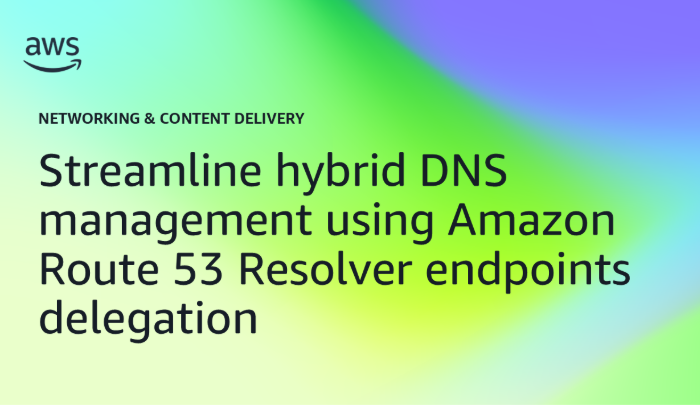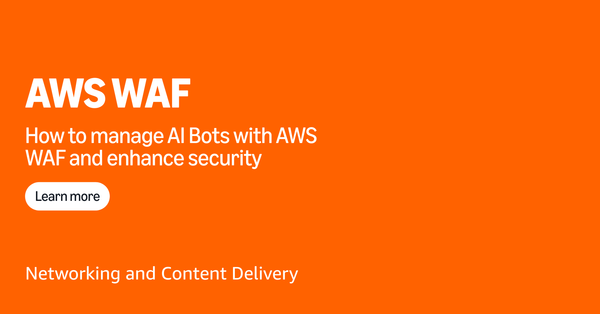Networking & Content Delivery
Category: Technical How-to
Secure customer resource access in multi-tenant SaaS with Amazon VPC Lattice
In this post, we provide prescriptive guidance for building resilient and scalable multi-tenant Software-as-a-Service (SaaS) network architectures to address common challenges such as managing overlapping IP addresses, complex CIDR planning, and scaling connectivity to thousands of customers. We explore multiple architectural approaches using Amazon VPC Lattice with TCP resources, and conclude with detailed implementation guidance […]
Amazon CloudFront now supports IPv6 origins for end-to-end IPv6 delivery
IPv6 adoption continues to accelerate worldwide as organizations move beyond the limitations of IPv4 address space. At Amazon Web Services (AWS), we’ve long supported IPv6 from end users to our Amazon CloudFront network, helping end users reduce latency, improve performance, and reach on modern mobile networks. Now, we are excited to take it a step […]
Protect your Amazon Route 53 DNS zones and records
Amazon Route 53 powers mission-critical DNS services for millions of applications worldwide, and protecting your DNS infrastructure is an important step for securing your applications.. An unintended DNS configuration change or deletion can disrupt the availability of your applications and impact your business operations causing lost revenue and more. To help safeguard your DNS from […]
Dynamic routing using Amazon VPC Route Server
Amazon VPC Route Server enables dynamic routing within Amazon Virtual Private Cloud (Amazon VPC) using Border Gateway Protocol (BGP). You can use Amazon VPC Route Server for effective and intelligent traffic control between cloud applications and on-premises systems. Amazon VPC Route Server uses BGP to provide advanced control over traffic paths, especially for failures, and […]
Streamline hybrid DNS management using Amazon Route 53 Resolver endpoints delegation
Introduction We recently announced that Amazon Route 53 Resolver Endpoint supports Domain Name System (DNS) delegation, allowing you to delegate authority for a subdomain from your on-premises infrastructure to Route 53 and vice versa. Previously, to implement DNS delegation and maintain a unified private DNS namespace across on-premises and in Amazon Web Services (AWS) environments, […]
Streamlining RISE with SAP Connectivity using AWS Cloud WAN
Under RISE with SAP, establishing network connectivity to the RISE with SAP Amazon Virtual Private Cloud (Amazon VPC) on Amazon Web Services (AWS) is your responsibility. Traditionally, users have relied on AWS Site-to-Site VPN, AWS Direct Connect, Amazon VPC peering, or AWS Transit Gateway to connect their on-premises networks and existing AWS accounts to the […]
Secure internet-based access to SaaS PrivateLink endpoints using AWS Verified Access
Introduction As cloud adoption grows, software-as-a-service (SaaS) providers on AWS are increasingly using Amazon Web Services (AWS) PrivateLink to securely deliver services to their customers. PrivateLink enables seamless, private connectivity between VPCs without exposing applications to the public internet, which makes sure of strong security and consistent network performance. However, what if you want to offer this […]
Enhancing Pinterest’s organizational security with a DNS firewall: Part 2
This post was authored by Ali Yousefi, Senior Security Software Engineer on the Infrastructure Security Team at Pinterest Introduction In part 1 one of this two-part blog series, we demonstrated how Pinterest gained visibility into DNS traffic originating from its VPCs by enabling Amazon Route 53 Resolver query logs across its Amazon Web Services (AWS) […]
Enhancing Pinterest’s organizational security with a DNS firewall: Part 1
This post was authored by Ali Yousefi, Senior Security Software Engineer on the Infrastructure Security Team at Pinterest Introduction Network security has become an increasingly important focus area in cloud security as more organizations shift to the cloud. Organizations can take an active approach in protecting themselves and their data from various threats by strengthening […]
How to manage AI Bots with AWS WAF and enhance security
Introduction The first web crawler was created in 1993 to measure the size of web, and they have now evolved into modern bots powered by agentic AI. Today’s internet is increasingly populated and dominated by automated AI bots that interact with applications to support AI-related tasks. We classified AI bots into three types: AI scrapers, […]









